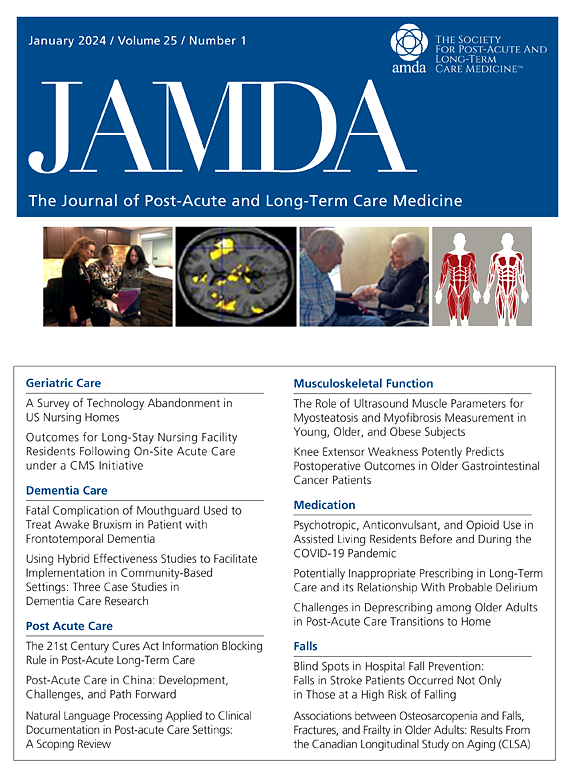Aizu队列研究(LOHAS)中社区老年人继发单腿站立时间较短与独立性丧失或死亡的关系
IF 4.2
2区 医学
Q2 GERIATRICS & GERONTOLOGY
Journal of the American Medical Directors Association
Pub Date : 2025-06-11
DOI:10.1016/j.jamda.2025.105688
引用次数: 0
摘要
目的:虽然之前的一份报告表明,原发性单腿站立时间(OLST),定义为两条腿较长的OLST,与死亡有关,但继发性OLST(较短的OLST)与死亡之间的关系尚不清楚。本研究调查了继发性OLSTs与独立性丧失(LOI)或死亡之间的关系。设计:基于人群的队列研究。环境和参与者:本研究在日本的两个城市进行。2008年至2010年间,对年龄≥65岁的独立成人进行双侧OLSTs测量。初步分析共纳入3278名参与者。方法:采用LOI和死亡的综合结果。LOI被定义为在日常生活的基本活动中需要完全的支持,对应于日本长期护理保险认证的护理等级3 - 5。使用Cox比例风险模型来估计继发性OLSTs与LOI或死亡之间的校正风险比(hr)和95% ci。我们还对原发OLST(≥30秒)正常的患者进行了额外的分析,并评估了继发OLST的独立作用。结果:在随访期间(中位:7.22年),452名(13.7%)参与者发生LOI或死亡。较短的继发性olst与LOI或死亡相关;继发olst患者的多变量HR (95% CI)为2.17(1.67-2.84)。结论和意义:较短的继发olst是老年人LOI或死亡的危险因素,即使原发olst在正常范围内。评估两侧的olst对于预测预后非常重要。本文章由计算机程序翻译,如有差异,请以英文原文为准。
Association of Shorter Secondary One-Leg Standing Time with Loss of Independence or Death in Community-Dwelling Older Adults in the Aizu Cohort Study (LOHAS)
Objectives
Although a previous report indicated that the primary one-leg standing time (OLST), defined as the longer OLST of both legs, is associated with death, the association between secondary OLSTs (the shorter OLSTs) and death remains unclear. This study investigated the association between secondary OLSTs and the loss of independence (LOI) or death.
Design
Population-based cohort study.
Setting and Participants
This study was conducted in 2 Japanese municipalities. Between 2008 and 2010, bilateral OLSTs were measured in independent adults aged ≥65 years. In total, 3278 participants were included in the primary analysis.
Methods
The outcome was a composite of LOI and death. LOI was defined as the need for complete support in basic activities of daily living, corresponding to care levels 3 to 5 of the Japanese long-term care insurance certification. A Cox proportional hazards model was used to estimate the adjusted hazard ratios (HRs) and 95% CIs for the association between secondary OLSTs and LOI or death. We also conducted additional analyses limited to those with normal primary OLSTs (≥30 seconds) and evaluated the independent role of secondary OLST.
Results
During follow-up (median: 7.22 years), LOI or death occurred in 452 (13.7%) participants. Shorter secondary OLSTs were associated with LOI or death; the multivariable HR (95% CI) was 2.17 (1.67-2.84) in those with secondary OLSTs of <10 seconds, 1.54 (1.13-2.10) for OLSTs of 10-20 seconds, and 0.88 (0.56-1.37) for OLSTs of 20-30 seconds, compared to those with normal secondary OLSTs (≥30 seconds). These associations remained consistent in additional analyses limited to those with normal primary OLSTs.
Conclusions and Implications
Shorter secondary OLSTs are risk factors for LOI or death in older adults, even when the primary OLSTs are within the normal range. Assessing OLSTs on both sides is important for predicting prognostic outcomes.
求助全文
通过发布文献求助,成功后即可免费获取论文全文。
去求助
来源期刊
CiteScore
11.10
自引率
6.60%
发文量
472
审稿时长
44 days
期刊介绍:
JAMDA, the official journal of AMDA - The Society for Post-Acute and Long-Term Care Medicine, is a leading peer-reviewed publication that offers practical information and research geared towards healthcare professionals in the post-acute and long-term care fields. It is also a valuable resource for policy-makers, organizational leaders, educators, and advocates.
The journal provides essential information for various healthcare professionals such as medical directors, attending physicians, nurses, consultant pharmacists, geriatric psychiatrists, nurse practitioners, physician assistants, physical and occupational therapists, social workers, and others involved in providing, overseeing, and promoting quality

 求助内容:
求助内容: 应助结果提醒方式:
应助结果提醒方式:


